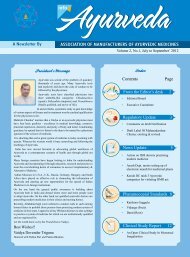Volume 2, No.5, July to September' 2013 - amam-ayurveda.org
Volume 2, No.5, July to September' 2013 - amam-ayurveda.org
Volume 2, No.5, July to September' 2013 - amam-ayurveda.org
You also want an ePaper? Increase the reach of your titles
YUMPU automatically turns print PDFs into web optimized ePapers that Google loves.
STORAGE<br />
S<strong>to</strong>re in a cool place in tightly closed amber coloured bottle, protect from<br />
light and moisture.<br />
THERAPEUTIC USES<br />
Murccha (syncope), Apasmara (epilepsy), Sosa (cachexia), Unmada<br />
(mania/psychosis), Karsya (emaciation), Arsa (piles), Agnimandya<br />
(digestive impairment), Vataroga (neurological disorders).<br />
DOSE<br />
15-30 ml orally with equal amount of water after meals twice a day.<br />
ASVAGANDHA<br />
(API, PART – I, VOL – I )<br />
Asvagandha consists of dried mature roots of Withania somnifera Dunal.<br />
(Fam. Solanaceae); a perennial shrub, found in waste land, cultivated filed<br />
and open ground throughout India; widely cultivated in certain areas of<br />
Madhya Pradesh and Rajasthan; roots collected in winter, washed and cut<br />
in<strong>to</strong> short pieces<br />
SYNONYMS<br />
Sansk : Hayagandha, Vajigandha<br />
Assam : Ashvagandha<br />
Beng. : Ashvagandha<br />
Guj. : Asgandha<br />
Hindi : Asgandh<br />
Kan. : Angarberu, Hiremaddina-gida<br />
Kash. : Asagandh<br />
Mal. : Amukkuram<br />
Mar. : Asagandha, Askagandha<br />
Ori. : Aswagandha<br />
Punj. : Asgandh<br />
Tam. : Amukkaramkizangu<br />
Tel. : Pennerugadda<br />
Urdu : Asgand<br />
DESCRIPTION<br />
(a)<br />
Macroscopic – Roots straight, unbranched, thickness varying with<br />
age, roots bear fiber-like secondary roots, outer surface buff <strong>to</strong> greyyellow<br />
with longitudinal wrinkles; crown consists of 2-6 remains of stem<br />
base; variously thickened; nodes prominent only on the side from where<br />
petiole arises, cylindrical, green with longitudinal wrinkles; fracture, short<br />
and uneven, Odour, characteristic; taste, bitter and acrid.<br />
IDENTITY, PURITY AND STRENGTH<br />
Foreign matter Not more than 2%,<br />
Total ash Not more than 7%,<br />
Acid-insoluble ash Not more than 1%,<br />
Alcohol (25%) soluble extractive Not less than 15%,<br />
(As per Appendix mention in API)<br />
ASSAY<br />
Aswagandha consists of not less than 0.2 per cent of <strong>to</strong>tal alkaloids, when<br />
assayed as follows:-<br />
Take about 30g accurately weighed of the powdered drug, cover with<br />
Alcohol (90 per cent) and allow <strong>to</strong> stand overnight. Extract for 6 hours<br />
so wet apparatus and concentrate <strong>to</strong> syrup residue. Treat with 25, 20, 15<br />
and 10 ml portions of 5 per cent Sulphuric Acid until complete extraction<br />
of alkaloid is affected.<br />
To the combined acid extract add an excess of Dragandorf’s reagent.<br />
Filter under suction and dissolve the residue in Ace<strong>to</strong>ne, Shake the ace<strong>to</strong>ne<br />
solution with freshly prepared suspension of 2g Silver Carbonate in 10<br />
ml of Water. Filter the solution and wash the precipitate with Ace<strong>to</strong>ne,<br />
Alcohol and water in that order. Pass sufficient Hydrogen Sulphide<br />
through the filtrate. Boil the solution for 10 minutes, filter and evaporate<br />
under vacuum in a tared flask. Add <strong>to</strong> the residue 5 ml of Ethyl Alcohol,<br />
evaporate <strong>to</strong> dryness, repeat the process once again and weight the residue<br />
<strong>to</strong> constant weight in vacuum dessica<strong>to</strong>r.<br />
CONSTITUENTS<br />
Alkaloids and withanolides.<br />
PROPERTIES AND ACTION<br />
Rasa : Tikta, Kasaya<br />
Guna : Laghu<br />
Virya : Usna<br />
Vipaka : Madhura<br />
Karma : Vatakaphapaha, Balya, Rasayana, Vajikarana<br />
IMPORTANT FORMULATIONS<br />
Asvagandhadyarista, Asvagandhadi leha, Balasvagandha laksadi taila.<br />
THERAPEUTIC USES<br />
Ksaya, Daurbalya, Vataroga, Sotha, Klaibya.<br />
DOSE<br />
3-6g of the drug in powder form<br />
(b) Microscopic – Transverse section of root shows cork exfoliated<br />
or crushed; when present isodiamatric and non-lignified; cork cambium<br />
of 2-4 diffused rows of cells; secondary cortex about twenty layers of<br />
compact parenchyma<strong>to</strong>us cells; phloem consists of sieve tubes, companion<br />
cells, phloem parenchyma; cambium 4-5 rows of tangentially elongated<br />
cells; secondary xylem hard forming a closed vascular ring separated by<br />
multiseriate medullary rays; a few xylem parenchyma.<br />
Picture 1: Ashwagandha Fruiting Twig<br />
info Ayurveda, <strong>Volume</strong> 2, <strong>No.5</strong>, <strong>July</strong> - Sept’ <strong>2013</strong><br />
7




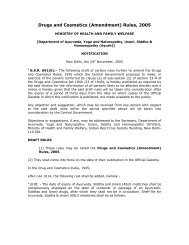
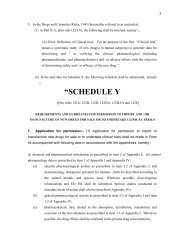
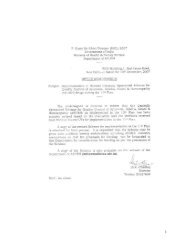

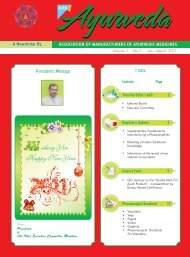

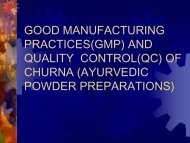
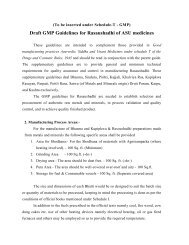
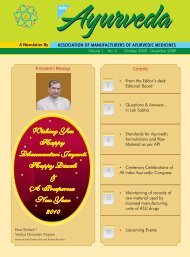
![[To be published in Gazette of India Part II Section 3, sub-section iii]](https://img.yumpu.com/28570283/1/190x245/to-be-published-in-gazette-of-india-part-ii-section-3-sub-section-iii.jpg?quality=85)

